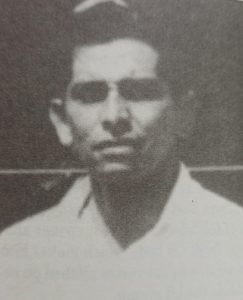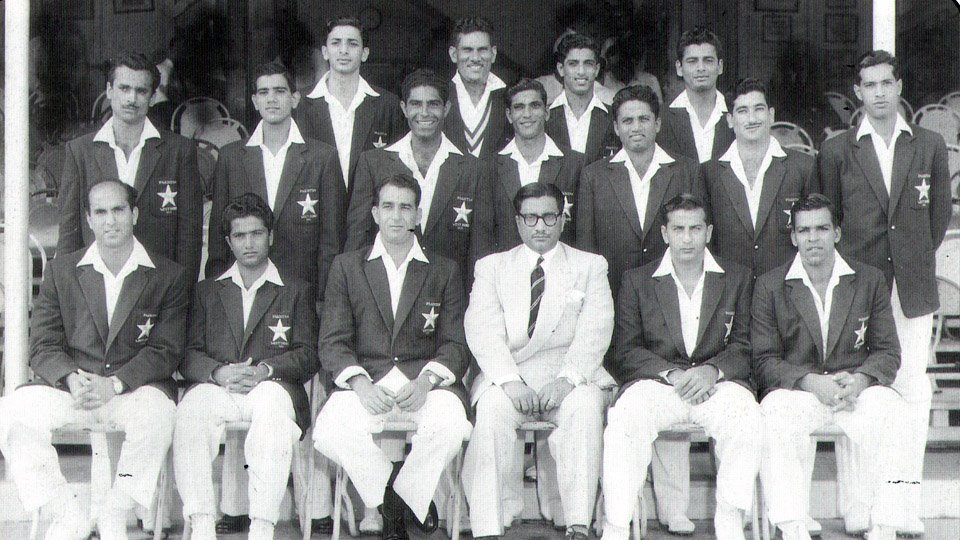Pakistan has a rich cricket history. One of their early recoveries from the aftermath of independence, the new state of Pakistan, did not lag behind in its pursuit to contribute to the world in other fields of discipline. Pakistan had organized the national games in April 1948 in preparation for the London Olympic Games. Justice A.R. Cornelius, father of cricket in Pakistan, in company with another notable Nawab Mamdot, the first Chief Minister of independent Punjab, founded the cricket authority and invited the West Indies cricket team on a tour of India to play three matches in Pakistan.
The team led by J.D.C. Goddard included two of the three W’s and George Headley, dubbed the black Bradman, and he soon showed his class. The third W,s Frank Worrell, did not come on this tour. The authorities of cricket in Pakistan soon charted out their course of action for an assault on winning test status for the newborn country. The road was slippery and had many pitfalls, yet the core of cricketers that were available had already played first-class cricket for what was then known as the Northern India Cricket Association.
They were quite prominent names and soon proved that they were fully capable of discharging the duties the nation had put on their shoulders. The visitors arrived in Pakistan at the end of October and played three matches. The nation had suffered yet another irreparable loss in the death of the Father of the Nation, Quaid-e-Azam Mohammad Ali Jinnah, on September 11 of that year.
The first match against Sindh XI was played at the famous Karachi Gymkhana Ground, which at that time was the only cricket ground worthy of holding a match of any sort. It had long matting and a grassy square with a seating capacity of nearly two thousand. The match against the Sindh XI was drawn, and the visitors soon realized that the new nation was well served with cricketers who could take on the very best in the years to come.

Batting first, the Sindh XI could only muster 173 runs. Cameron and Jeff Stolmeyar were almost unplayable and claimed four for 62 and three for 40, respectively. The West Indies replied with 263 for seven before declaring their innings closed. Joey Carew made a fine century, while Everton Weeks notched up grand 54 runs Skipper Anwar Hussain Khokhar bowled well to capture four wickets for 66 runs with his medium-paced cutters.
In this match, Munawar Ali Khan, the fastest bowler in Pakistan, broke the wicket of West Indian Captain Goddard and repeated the feat in the Lahore unofficial Test as well. The match looked headed West Indies way when skipper Anwar Hussain played a classic inning and scored handsome 81 runs in the second inning.
They seemed to be down a fine stand for the eighth wicket developed between Badruddin and Mavalwala, who scored 51 and 48 runs, respectively, taking their team total to a respectable 284 for eight. Anwar Hussain declared the innings, leaving the visitors to score 197 to win the match in the remaining time, which was an impossible task.
The visitors made 61 for two wickets in their second innings, and the match ended in a draw. The visitors reached Rawalpindi to play their second match of the tour against Commander in Chiefs 11 at the Pindi Club Ground, which was the only ground in the city for these matches.
Decades later, however, Shahid Rafi, the young commissioner of Rawalpindi and Secretary of the Board of Control for Cricket in Pakistan, built a grand stadium in the city where Test and first-class matches are now played. The visitors won the match by nine wickets as the home team failed against Atkinson and Stolmeyar, who claimed three wickets each for 24 and 8 runs, respectively, and the entire team was bowled out for just 96 runs.
The West Indies scored 184. It was off-spinner Miran Baksh, now past his prime, who tested the might of the visitors and claimed five wickets for 61 runs. In the second inning, however, the home team fared better but could only score 187 as George Headley, known as Black Bradman, tore the batting apart and claimed six wickets for 49 runs.
The visitors needed 103 for the victory, which they achieved for the loss of one wicket. Bagh-e-Jinnah, previously known as Lawrence Garden, in the center of Lahore, was the next rendezvous of the visitors, where the only Test match was played, which ended in a draw. The match was played from November 27 to 30.
Batting first, Pakistan, fighting for its identity, showed a lot of grit and determination and scored 241, to which Nazar Mohammad and Imtiaz Ahmad contributed 87 and 76, respectively. Pace bowlers Gomez and Trim shared the wickets, with Gomez taking the lion’s share of four wickets for 51 runs. Other successful bowlers were Headley and Carew, who claimed two wickets each for 21 and 6 runs, respectively.
Trim had taken two for 53. The West Indies showed their class when they replied with 308, to which Weeks contributed 55; Richard 72; and Headley 57 were not out. Headley played with one hand, as he had injured his hand, yet showed his class. Munawar Ali Khan gave a fine demonstration of fast bowling and claimed four wickets for 103 runs, while right-arm leg spinner Mohammad Amin and left-arm leg spinner Shujauddin finished with three for 47 and two for 69, respectively.
Trailing 69 runs behind in the first innings, Pakistan went for the bowling and scored 280 for the loss of six wickets, and Mian Mohammad Saeed, a first-class cricketer and a bureaucrat who led the team, declared the innings closed. Imtiaz Ahmad scored a brilliant 131, and Mian Saeed also notched up a century.
Gomez once again became the most successful bowler, claiming four wickets for 70 runs and finishing the match with a haul of eight wickets, while wicket-kipper Goddard chipped in with two for 81. The West Indies could score only 98 for the loss of one wicket, and the match was left drawn.
Carew made 56, while Stolmeyar remained unbeaten with 33. The two teams for the unofficial Test match were the West Indies: J.D.C. Goddard (captain), Jeff Stolmeyar, G. Carew, Clyde Walcott, Everton Weeks, K. Richard, G.E. Gomez, C.A. McWatt, R.S. Christiani, George Headley, and J. Trim.
However, the Pakistan squad consists of Mian Mohammad Saeed (captain), Nazar Mohammad, Imtiaz Ahmad, Fazal, Mahmood, Alimuddin, Maqsood Ahmad, Anwar Hussain, M.E.Z.Gazali, Mohammad Aslam, Shujauddın, Mohammad Amin, and Munawar Ali Khan.
This tour created a lot of interest in the country, and young aspiring cricketers took to the streets, where they played cricket with makeshift wickets and grounds. The schools and colleges also contributed to the game, and a lot of cricket was played. Rubie Shield was played in Karachi for schools, while inter-collegiate and inter-university cricket generated a lot of interest and threw up new talented cricketers.
Hanif Mohammad, Ikram Elahi, Mohammad Munaf, Mohammad Farooq, Wallis Mathias, Antao DeSouza, Intikhab Alam, and Aftab Alam were a few of the cricketers Karachi produced from schools, while Lahore produced cricketers like the caliber of Saeed Ahmad, Javed Burki, Ijaz Butt, Khalid Qureshi, Khan Mohammad, Imtiaz Ahmad, Israr Ali, and a host of others.
All the visiting teams visiting Pakistan had to play against local associations, combined schools, and combined university teams, and this helped in improving the standard of the game. In fact, Radio Pakistan played the most crucial and leading role in popularizing this game. That became a household name in the country because of the running commentary radio broadcast.
Regional cricket was in vogue when Pakistan emerged on the map of the world. And this served the national sports organizations with new blood, but later this was discarded, and the national federations and associations took over full control of the affairs of these games, with schools, colleges, universities, and even the clubs playing no or very little part in the promotion of the games and sports in the country.
While sponsorship by multinationals and national organizations has been forthcoming in large numbers, the federations and board have failed to translate the dreams of the countrymen into reality. Today, the role of universities and colleges has been taken over by banks and other organizations, where several sportsmen get jobs but are wasted, and many have gone into oblivion without contributing their share to the national aspirations.
Pakistan’s next rendezvous was in Ceylon (Sri Lanka), where it played two unofficial Test matches and two other side matches. The team was: Mian Mohammad Saeed (captain), Nazar Mohammad, Imtiaz Ahmad, Alımuddin, Munawar Ali Khan, Khan Mohammad, Fazal Mahmood, Maqsood Ahmad, U.R. Chippa, Mohammad Amin, Major S.A. Rehman, Rusi Dinshaw, Murawat Hussain, while K.K. Collector was the manager.
The team played four matches, including two unofficial test matches. Pakistan won the series. The first match of the tour was played against a Ceylon XI, which ended in a draw. The home team was bowled out for 149 runs as Khan Mohammad claimed 4 for 19. In reply, Pakistan made 231.
Mian Saeed scored 91 brilliant runs. Nathaniel and Sathyendra Coomeraswami were successful bowlers, claiming four wickets each for 63 and 45 runs, respectively. Batting a second time, the home team was precariously placed at 191 for nine when play ended.
The second match against the Sinhalese XI was the best match of the tour, in which the home team showed guts, scoring 344 runs, to which Rodrigo contributed a century and Wijesinghe made 72. Maqsood Ahmad and Khan Mohammad were the successful Pakistan bowlers, claiming three wickets each for 49 and 42 runs, respectively.
Pakistan fared badly and was bowled out for 234, mainly due to fine bowling by Wijisinghe, who claimed four for 42. Sinhalese XI declared their second innings at 98 for two. Pakistan had scored 192 for five when the match ended in a draw. Alimuddin scored 65, and Maqsood Ahmad, 65, not out-batted courageously and saved the match for Pakistan.
Wijisinghe finished with seven wickets for 82 runs in the match. The first Test was played in Colombo from March 1 to 4, and Pakistan won by an innings and 192 runs. Ceylon (now Sri Lanka) was bowled out for a paltry 112, to which Wijisinghe and Kasipilani contributed 29 and 24 runs, respectively. Paceman Khan Mohammad and S.A. Rehman Chippa shared six wickets between themselves for 36 and 29 runs, respectively, and Masood claimed two for 13.
Pakistan replied with 399, to which Alimuddin contributed 67, Mian Saeed 93, Maqsood Ahmad 85, and Fazal Mahmood 36. Wijisinghe was the most successful bowler, claiming five for 105, and Dezoya claimed three for 99. In the second Test match at the Colombo Oval, Pakistan again scored a thumping victory by 10 wickets.
Pakistan made 474 runs. Nazar Mohammad and Murawat Hussain scored grand centuries. Nazar Muhammad made 170, Murawat scored 164, and Fazal remained unbeaten at 65. Wijisinghe claimed 2 for 144, while Coomraswami was the successful bowler, claiming 4 for 81, with Wordsworth taking 2 for 36.
In reply, Ceylon could only manage 311 runs, to which Captain Desaram contributed 118 and Gunawsekara scored 120 runs. Khan Muhammad claimed five for 72, and Fazal Mehmood claimed three for 52. Ceylon made 210 in the second inning. Navaratne scored 58, while Khan Muhammad claimed two for 70, Anwar took two for 12, and Amin took two for 46. Pakistan’s first decade in Test Cricket is one of the most successful eras in cricket history.
